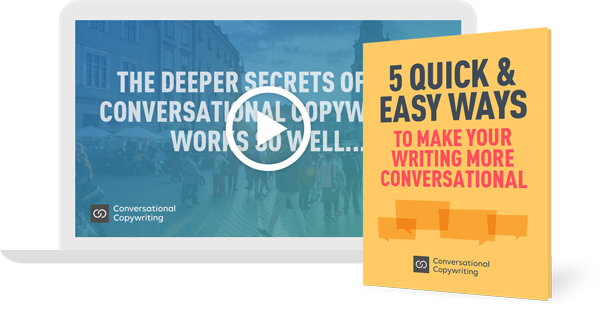Take your pick. I cover the same ground in both the video and the text on this page.
Some people prefer video. Others prefer reading.
Still reading?
OK then. Let’s start with a real-life conversation.
There are a couple of reasons why we pause when talking.
One reason is to place emphasis on what we just said.
The second reason, and the most common one, is that we pause as a signal that it’s the other person’s turn to start talking.
A conversation is cooperative. Both parties get to participate. And those brief moments of silence are part of that cooperative process. (My post on the Cooperative Principle.)
A pause is a signal that it’s your turn.
At least, that’s what happens in a good conversation. In a bad conversation, one person never pauses and just talks and talks and talks.
The closest equivalent online is text messaging.
Text messaging is close to a real conversation because of the pauses.
You type something, click the send arrow and wait.
Nothing happens for a moment and then, with many messaging apps, three “dancing” dots appear, signaling that the other person is typing.
Texting is wonderfully conversational and cooperative. We always take turns.
And if you’re an online writer, tasked with writing a script for a chatbot, you actually write those pauses into your script.
A chatbot doesn’t need to pause. The next part of the script is loaded and ready to go. But we write in a 2, 3 or 4-second pause as a way to make the interaction feel more natural and conversational.
There are ways we can build pauses into sales pages and web content too.
If you want your online copywriting and content writing to feel conversational, there are a lot of things you can do.
First off, you’re going to use simple, everyday language.
But you can also make your writing feel more conversational by creating moments of silence along the way.
There are two approaches I take when I want to create a moment of silence, or a pause.
First, after a few paragraphs, I thrown in a simple, open-ended question.
Like…
When was the last time you had a really, really good conversation?
When I ask that question, I’m forcing you to stop reading and to think.
I’m being quiet. I’m giving you a turn.
It’s not like a real pause in a real conversational, but I’m still giving a nod to that sense of cooperation. I want the reader to feel they are part of what I’m trying to say.
Another, related way to create a pause – and to include your reader – is to ask them to imagine or think about something. Not a question, but similar.
Imagine what it would be like if your colleagues REALLY listened to your point of view.
It works the same way as a question. You are pausing, and creating a moment of silence. You’re inviting the reader to take part. To take a turn.
Creating these pauses is a powerful way to make your writing more conversational.
Like I said earlier, there are a number of ways to make your writing more conversational.
Creating moments of silence, or pauses, is one of the most powerful tools at your disposal.
If you want to know more – to get access to the full toolbox – find out about the course I teach on Conversational Copywriting.

Nice explanation and practical suggestions!
Thanks, Nick
Thank you, Nick. You cleared up some things I’ve been struggling with and gave me some new directions to think about. You’re a great teacher.
Clear, elegant and evocative – nice. I particularly enjoyed watching your emphasis on turn-taking. It’s something that certainly takes some skills – even with rule-based devices.
Your tone was excellent, btw.
Cheers
David
Good to hear from you! Glad you enjoyed the video. And yes, taking turns is the bedrock of conversation – for better or for worse.